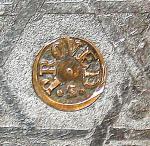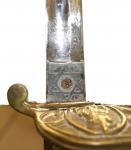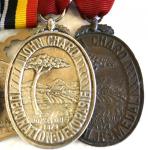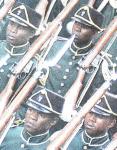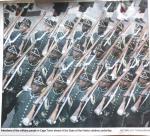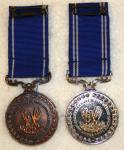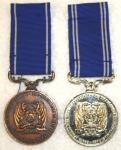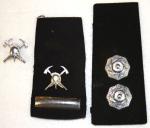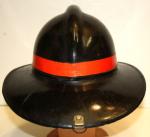-
Posts
13,225 -
Joined
-
Last visited
-
Days Won
22
Content Type
Profiles
Forums
Blogs
Gallery
Events
Store
Everything posted by Mervyn Mitton
-
-
-
-
-
-
-
-
-
-
I think it is disappointing that such a major Forum as ours seems to have so few postings under edged weapons. Swords and bayonets are an important subject and the variety of patterns and Countries is endless. Even if you don't have some of your own - next time you visit a museum take a few photos of special ones from your Country to show-us. The one I am posting today is a British Naval Officer's and with the Royal Cypher for King George V th. - we know that it dates between 1910 and 1935. Since it is presently in South Africa there is the possibility that it was for a South African Naval Officer - however, their pattern off dress and equipment at that time was almost identical to the British and without a name I doubt we will have an answer. One clue might be the proof mark - we have established in previous postings that S.A. swords were often supplied by Trading Importers - and this one one does lack a name from a major maker. The sword is of the 1827 pattern when standard regulations were laid down - and conforms to the change in Crowns made in 1901 , when the Imperial or, Tudor Crown replaced the St. Edward's Crown. In 1952 Queen Elizabeth reverted to this last style. The fittings are always brass - which were gilt, however, over the years this tends to wear off - not a problem if you are prepared to polish the brass. The white skin of the grip is White Ray - this is more 'nobbly' than shark skin and gives a good grip. We must always remember, that whilst these swords are today purely ceremonial, in earlier days they were weapons of offence. Naval Swords are always sought after - either by collectors or, new young officers. A new dress sword today is somewhere in the region of approx. £5-6000 ($8000-9600) I look forward to comments.
-
Well done, Gordon - I shall look forward to your further posts. I used to have a similar Berlin Shako and assumed it was 1920's/30's. Would that be your dating for this piece ? Now, how do we encourage other members to show some of their Police items ?
-
Thankyou for comments everyone. I had spotted the mis-mounting - however, I'm a little undecided as to change them - or not ? Thomas rightly points out there is one school of thought that says leave them. Our medal Forum is strange - I posted a few weeks ago a quite rare 1877-8 Kaffrarian War medal to the Frontier Armed and Mounted Police - under 60 with this bar date combination. No replies and only about 70 views before it went down the list. This doesn't bother me in the least - but, it does leave doubts as to just how much knowledge there is for these historical old wars and military events. Post WW1 or WW2 and there is immediate interest - perhaps it is that members like the more modern research ?
-
This interesting group of South African Medals is for the period prior to 1994 - when the Government changed. This was the time of the Border Wars in South West Africa - when S.A. was fighting to help the rebels in Angola - who, in turn , were being supported by Russia and Cuba. From left : The Pro Patria Medal. Awarded for the defence of Sth. Africa or, Prevention of Terrorism. The rare bar - the only one awarded - is for operations in Cunene. The value of the medal increases sharply with this bar. What is interesting is that S.A. probably never had more than about 12 Battalions fighting at any one time - and yet, over 350,000 were issued. This is the first type with suspension ring. General Service Medal.Instituted Jan. 1st. 1983 and for service within South Africa. Southern Africa Medal. Awarded for specific cross-border raids. This is quite a rare medal and was originally to have been made from the metal of a T34 Russian tank. The metal was found to be inferior and eventually, a small amount was included with the cupro-nickel. The prowling leopard is a lovely design and sums up the medal. Quite rare. The final ones - 4 and 5 are the John Chard Decoration and the John Chard Medal. They replaced the Efficiency medal. They both bear the name of John Chard VC - he was the garrison commander at the Defence of Rorke's Drift in 1879. A pictorial representation of the trading post is shown on each medal. Not common to have both versions together. The holder of the Decoration is entitled to the initials ' JCD ' after his name. This combination is not uncommon - but does show the holder had seen considerable service. These are not named - but, numbered. However, the medals are not numbered for the holder, but sequentially for issue of that medal. He was also entitled to a another higher award and also, the Rhodesian GSM. With the change of Govt. it is now quite difficult to look up these more modern medals.
-
Brian - that's a great personal badge to have. What do the initials after Norwich stand for ? Ian - I fully agree with you - there is a lot of interesting material out there - and of particular collecting value would be some of the early Insurance marks to go on buildings. An important part of our history, since the brigades turning out would only work on a fire if their insurance symbol was displayed. Unless anyone disagrees, then lets include both Fire and Ambulance. I don't suppose there will be a lot, however, if it gets excessive we can ask Nick to form a new sub-forum.
-
-
-
This uniform was worn by the elite State President's Guard up until the end of white rule in the early 1990's. For the Presidential State of the Union address last week they have revived the Guard. Both the uniform and the shako have been retained in the original form - however, new badges are on the shako and the ostrich plume on top has been taken off. I am showing a picture of how it looked. What I did find surprising , is that they have taken to using the old .303 Lee Enfield rifle, but with carbine bayonet. This is a heavy rifle , ( 9lb. 4 oz. : app.4.4K's) but is ideal for drill movements. Some years ago the British Army wanted to keep using them for Parades, but it was decided they must use the standard rifle of the day.







